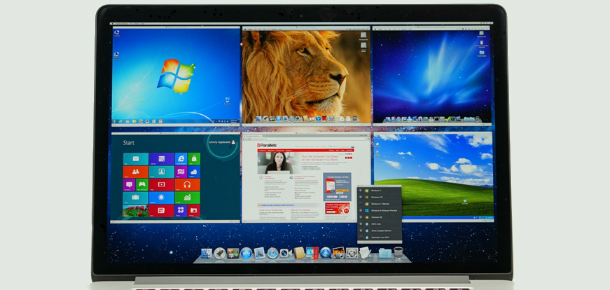As someone who uses both Macs and PCs, I’ve long had my eye on Parallels Desktop. For the unfamiliar, Parallels was the first Virtual Machine client for the Intel-based Mac OS. Debuting in 2006, it quickly caught on, winning MacWord 2007’s Best in Show. I’ve messed with it in the past, but never had a need that justified the price tag (more on that later). However, Parallels offered Techcitement a free copy of version 8 so that we could mess around under the hood, and I wasn’t about to say no. The downside was that I didn’t have a Mac powerful enough to run it. It took me so long to get my hands on one that Parallels 9 was just released. With that said, the basic software remains unaltered, so I decided it was pivotal to finish this review.
Let me begin by noting that the install of Parallels on my 2007 MacBook Air was seamless. It took almost no time at all to download and install. After the install finished, I was treated to a “New Virtual Machine” window that was clear and easy to read. Parallels is often promoted as a way to run Windows on a Mac, so I was pleasantly surprised to see not just an option to add or migrate over an existing Windows install, but also the option to download Ubuntu Linux, Google’s Chrome OS, and Google Android. I’d honestly never considered running Android on my MacBook before. I chose to install both Chrome and Windows 7 for the purpose of this review and swiftly found myself using only Windows.
The tricky thing is explaining how Parallels worked, because it’s so damn seamless. This is particularly true if you run it in Mac Mode, which presents each application as a floating window of its own. Most will likely opt to run it in a dedicated Windows window. Also, you can use it for more than just non-Apple operating systems. I was also able to use it to test Mac OS 10.8 on my system and intend to use it to test 10.9.
There are two downsides to Parallels. The first is specs. While the machine will run on a Core 2 Duo, I don’t recommend it. Yes, it’s responsive on a 2007 MacBook Air, but it’s not something I’d recommend as a daily driver. If your Mac is a pre-i3/i5 model, I recommend using Boot Camp (we’ll come back to that in a minute). Parallels works great with Retina Display MacBooks and has since version 7.
The bigger downside is cost. Assuming you didn’t already splurge and get Parallels before now (upgrade pricing is $50), you’re normally going to be out $80. There’s a student edition for $40, a better deal than upgrade pricing. There’s also a frankly insulting “Switch to Mac” edition for $100 (on sale for $55 on Amazon). Keep in mind, those prices are before the cost of a Windows disk.

Your monies. We wants ALL of it.
What makes those price points more painful is that your Mac can already run other OSes. Boot Camp, Apple’s Multi-OS solution, lets you reboot in Windows or the Linux distro of your choice. Know how much Boot Camp costs? Nothing.
The advantage of Parallels over Boot Camp, of course, is that you can run both OSes side by side. While that may seem like a silly reason to spend at least $40, I can think of several work environments where that would rock muchly. Like say, if you’re an OS reviewer. Assuming you work in such an environment and can convince your purchasing department to foot the bill, I recommend Parallels. Otherwise, stick with MacOS with occasional furloughs via Boot Camp.


Comments are closed.